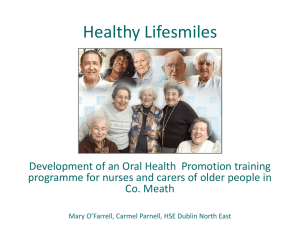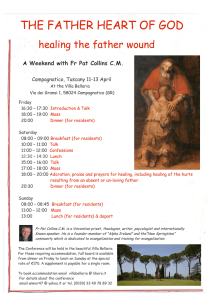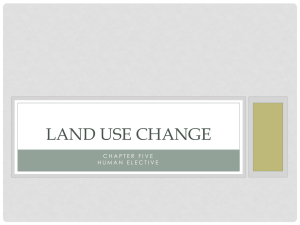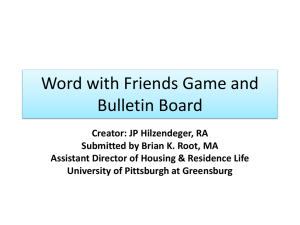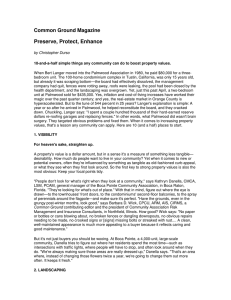Langer and Rodin (1976)
advertisement
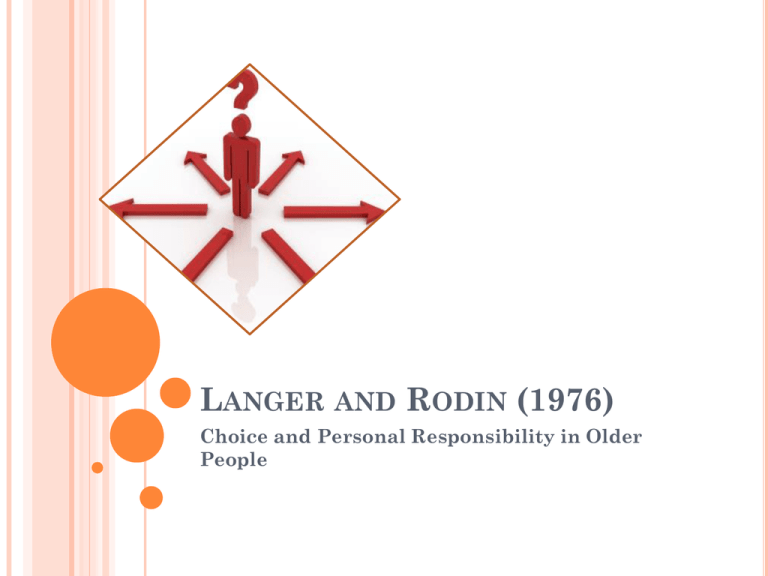
LANGER AND RODIN (1976) Choice and Personal Responsibility in Older People CONTEXT Researchers conducted research on choice, selfdetermination, and health. They found that people would take greater risks when they perceived more choice Langer looked at how choice could reduce stress for surgical patients. Interested in whether decline in abilities as we age is due to physiological reasons or a lack of choice in the environment. AIM To investigate whether giving greater choice and personal responsibility to residents of a residential home has a positive effect. PROCEDURE- SAMPLE 91 residents on 2 floors of a residential home. Floors had little contact. Quasi-experimental design- participants were the residents of each floor. They were not assigned to a floor. The groups were not matched. Experimental group: Floor 4. 39 women, 8 men. Control group: Floor 2. 35 women, 9 men. Age range: 65-90yrs. PROCEDURE-METHOD Field experiment- carried out in a residential home. Both groups called to a residents meeting by the hospital director. Given a plant and told of regular film screenings and a new complaints procedure. PROCEDURE- METHOD CONT. Experimental group: Given a choice of plant and the options of being responsible for it’s care. Told they could rearrange the furniture. Allowed to choose which films are screened. Complaints: Told it was their responsibility to make the home as they wanted it. PROCEDURE-METHOD Control group: Given a plant- no choice. Told a nurse would water it for them. Told their rooms had been arranged for them for maximum comfort. Told what films would be shown. No mention made of their responsibility to make the care home as they wanted. PROCEDURE- METHOD CONT. DV- self-report using a rating scale. (0= none to 8= total). Happiness Activity Perceived control over their lives. Tested one week prior to director’s talk and 3 weeks after. Nurse giving the questionnaire rated each resident for alertness on the same scale. Nurses also recorded resident behaviour, e.g. time spent visiting others. FINDINGS Enhanced choice condition reported feeling happier and more active, and were rated as more alert. 93% rated by nurses to have improved in overall functioning. Control condition Less happy, active and alert. Higher perceived control scores. Many residents reported that they did not understand this question so the contrary finding was disregarded. 21% rated by nurses as having improved in overall functioning. CONCLUSIONS Welfare of elderly in residential homes strongly affected by the amount of personal choice and responsibility they are given. Only the way in which intervention was given differed- both groups received the same things- it shows that personal choice was the cause of resident’s improvements. EVALUATION- STRENGTHS Ecological validity- conducted in a real nursing home with real residents given a realistic intervention. Applicable to the care environment. Useful. Good experimental control- both groups had a very similar experience. External and internal reliability- easily replicable. Controlled for bias with double-blind procedurenurses were not aware of the purpose of the study so unbiased by their own opinions of the outcome. EVALUATION- WEAKNESSES Quasi-experiment- participants not randomly allocated to condition (floor). Avoided separating residents for ethical reasons. Greater sociability in the experimental group who spent more time visiting friends. Generalisability- unrepresentative sample. Few men. Single residential home may not apply to other settings. Poor validity of the measure- question on perceived control poorly worded. Residents did not understand this measure. PAST EXAM QUESTIONS Section A 1. Outline the procedures of Langer and Rodin’s (1976) research ‘The effects of choice and enhanced personal responsibility for the aged: A field experiment in an institutional setting’. [12] 2011. Section B 1. Evaluate the methodology of Langer and Rodin’s (1976) research ‘The effects of choice and enhanced personal responsibility for the aged: A field experiment in an institutional setting’. [12] 2010. 2. With reference to alternative evidence, critically assess Gibson & Walk’s (1960) research ‘TheVisual Cliff’. [12] 2009. ADDITIONAL RESOURCES Check out this study video on YouTube: http://www.youtube.com/watch?v=P8oAlPW86aw



